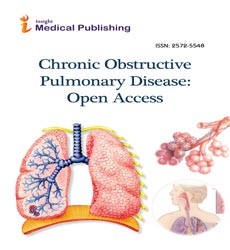Abstract
Minute lesions of alveolar damages in lungs of patients with stable chronic obstructive pulmonary disease
Objective: To reveal the mechanism underlying recruitment of neutrophils in chronic obstructive pulmonary disease (COPD) lungs and to investigate the role of minute lesions of alveolar damage (MLADs) in emphysema development.
Methods: Seventy-four lobes from 74 patients with stable COPD, and 78 lobes from 78 patients without COPD (controls) were immunohistochemically examined.
Results: MLADs presented as microscopic foci of inflammatory lung injury where alveolar epithelial cells had fragmented and disappeared, and ring-like or tubelike capillary structures had disappeared from the alveolar septae. MLADs were detected in 11 of 74 COPD patients. Tumor necrosis factor (TNF) -α+ macrophages and hypoxia inducible factor (HIF)-2α+ macrophages were detected in 100% of patients in the smoking group with or without COPD and in all patients with COPD exhibiting MLADs. The numbers of neutrophils in alveolar septae and alveolar spaces were significantly larger in the COPD smoking group and non-COPD smoking group than in the non-COPD non-smoking group, and the numbers of neutrophils were tend to be larger in and around MLADs than in lung tissues located away from MLADs in smoking patients with COPD. Masson body-like tissues estimated to be organizations of exudates as well as mild interstitial fibrosis estimated to represent the fibroproliferative phase of MLADs were observed in patients with COPD and smoking patients without COPD.
Conclusion: These findings suggest the followings: (1). HIF-2αÃÆïÃâüÃâââ¬Â¹macrophages and TNF-αÃÆïÃâüÃâââ¬Â¹macrophages induced by hypoxia caused by smoking play an important role in the recruitment of neutrophils, (2). MLADs develop in lungs in which large number of neutrophils have been recruited probably by deterioration of hypoxia and play an important role in the development of subsequent full-scale emphysema.
Author(s):
Iwao Emura, Hiroyuki Usuda and Kazuhiro Satou
Abstract | Full-Text | PDF
Share this

Google scholar citation report
Citations : 130
Abstracted/Indexed in
- Google Scholar
- China National Knowledge Infrastructure (CNKI)
- Publons
- Geneva Foundation for Medical Education and Research
- Secret Search Engine Labs
Open Access Journals
- Aquaculture & Veterinary Science
- Chemistry & Chemical Sciences
- Clinical Sciences
- Engineering
- General Science
- Genetics & Molecular Biology
- Health Care & Nursing
- Immunology & Microbiology
- Materials Science
- Mathematics & Physics
- Medical Sciences
- Neurology & Psychiatry
- Oncology & Cancer Science
- Pharmaceutical Sciences

